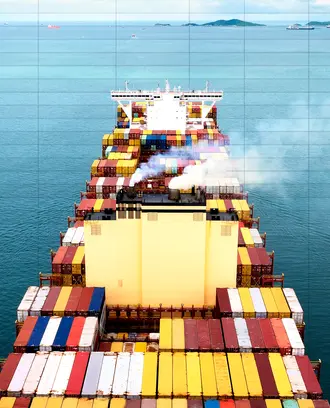Credit: Huan Tran
Managing supply chains in 2020 is hard. It means always questioning what will happen next, as the globalized economy puts forth an overlapping series of new opportunities and critical disruptions.
We asked leaders in industries enmeshed in global supply chains – apparel, venture capital, computing hardware, and international theaters – about their greatest challenges, the technology changing everything, and supply chain visibility.
What keeps you up at night — what aspect of supply chain is most challenging?
Alejandro Tejado Donde, procurement and supply chain global head, Cinépolis
Alejandro Tejado Donde, MBA ’07, is procurement and supply chain global head at Mexican cineplex chain Cinépolis: Even though we try to mitigate certain risks and have prepared several alternatives, there are political, macroeconomic, and regulatory aspects that impact all industries, and as of late these have been unstable. Additionally, technology keeps evolving at a fast rate, and it’s hard to keep up, so there is always room to learn. Finally, there is intense competition within all industries, and I constantly think how can we use supply chain to get additional competitive advantages.
Luis Nava is senior director of global sourcing and manufacturing at Converse: Our teams are having to manage more and more complexity every day, from the sourcing of new materials to the development of new manufacturing methods to accelerating how we get product to market.
And there’s always the constant risk of disruption to demand and supply. Political instability, climate change, and global health emergencies are just a few examples of the external factors that could drive internal impact on our business and challenge traditional supply chain design.
David Anderson, managing general partner, Supply Chain Ventures
In today’s volatile environment, speed and agility are equally or more important than cost. We need to learn how to balance the day-to-day delivery of results with the efforts to become resilient organizations.
David Anderson is managing general partner at Supply Chain Ventures, a Boston-based venture capital partnership: As an investor, we put up the money, but we don’t start the companies. We see many areas in supply chain that could use innovation, but founders have yet to come forward with solutions.
From your point of view, what technologies are most likely to remake the supply chain in the next three to five years?
Tejado Donde: First, data information and analytics. There is so much information — handling it is key to improve visibility and forecasting. Then automation — from robotic process automation to warehouse artificial intelligence, automation is the natural step in order to focus on the strategic aspects of the supply chain. Finally, blockchain. I see that more on the 5-year-plus horizon, but there are attractive benefits like traceability there.
Luis Nava, senior director of global sourcing and manufacturing, Converse
Nava: I’m excited about using digital technologies to create, make, and sell product. This will allow us to accelerate our speed to market, reduce cost, minimize our environmental impact, and improve quality.
Also new, disruptive technologies in textile, apparel, and footwear manufacturing will allow us to create things that we weren’t able to make before at scale. A great example of innovation in this space is Converse’s Renew Collection, featuring our Chuck Taylor All Star franchise. Through Renew, we’ve explored new methods of make that both lessen our environmental impact and make smart use of more sustainable materials, like recycled textiles, plastics, and our own leftover canvas.
As we were exploring ways to enable individual style for our consumer via our canvas, we had an unlock: could the Chuck Taylor be built out of existing materials? We challenged ourselves to develop alternative methods of creating our footwear by leveraging post-consumer and post-industrial waste. Because we’re starting with the Chuck Taylor, we can achieve global scale quickly. That means that, within the next year, there will be hundreds of thousands of pairs of Chucks made from upcycled and/or recycled materials — diverting tons of waste from landfills.
Jeremy Cram, vice president of supply chain, Micro Center
Jeremy Cram, SM ’97, is vice president of supply chain at Micro Center, a computer and electronics retailer headquartered in Hilliard, Ohio: In terms of what’s shaping the industry broadly, I would say artificial intelligence, specifically better forecasting methods to ensure the right inventory in the right places at the right time. And automation for warehousing and fulfillment to decrease costs and increase speed. Self-driving vehicles for delivery may be more than five years away, but since transportation is the largest cost of most supply chains, anything that can reduce these costs would be a huge benefit.
Anderson: The major innovation will be around incorporating real-time data and artificial intelligence and machine learning into supply chain decision-making. Real-time data will allow companies to better understand how weather, traffic, and customer behavior, among other factors, will affect supply chain operations. AI/ML tools will allow analysis of past and present decisions to see if there are better and more effective options to manage complex supply chains.
On a scale of 1 to 10, where would you rate your firm on supply chain visibility and transparency? What’s keeping you from getting to 10?
Tejado Donde: On visibility, I would say we are at 5. We need to consolidate all our supply chain systems. Transparency, also a 5. We don’t yet have full end-to-end visibility and traceability.
Cram: Visibility would be 5. It’s difficult for us to track inbound shipments across the broad array of carriers used by our vendors, and it’s difficult to easily track freight coming from overseas.
Anderson: What’s preventing companies from having good visibility in their supply chains are various data “black holes,” such as port load/unload times, local carrier data availability, detention/wait times at plants and warehouses, among other information that prevents companies from knowing accurately where their shipments are at any point in time.
Transparency is a huge issue for companies wanting to operate responsible supply chains. Being able to see down global supply chains beyond first-tier suppliers is a major problem for companies wanting to make sure their customers understand the second, third, and subsequent tiers of suppliers are not using slave labor, engaging in illegal and dangerous mining, or operating unsafe work environments. It is and will continue to be a major problem for companies.
What’s the one thing you wish your senior leadership team better understood about supply chain?
Tejado Donde: For the most part we share the same vision; however, sometimes it is not as apparent to them the potential risks and benefits of having a visible, transparent, and efficient chain. Thus these functions are seen as a “complement” to the business more than core functions that could significantly hurt or improve financial results.
Nava: That we must create a data-driven culture to allow us to thrive in this new business environment. And that investing in data management technologies and recruiting data scientists is not enough to create a data-driven culture. In terms of our efforts in the analytics space, we’ve had great results using a three-pronged approach: a) anchor all analytics efforts on a performance management framework that is directly aligned with our strategic priorities b) favor clarity and simplicity over full visibility or automation, and c) use transparency and cadence to drive accountability.
Anderson: Senior leadership at companies has become more aware of supply chain issues over the last decade, but too many companies still treat supply chain as a cost center, not one that can be used as a competitive advantage. One only has to look at how Amazon has used supply chain to completely revolutionize the retail supply chain to understand that companies in most goods-producing and -selling industries can be out-competed by disrupters.
Given all the challenges, what gets you up in the morning? What part of your job are most excited about?
Tejado Donde: Professionally, I’m excited when there are challenges that require us to do things differently or find new approaches — I enjoy innovating and creating something new. The fact that for the most part I get to see the results of my work with our final customers makes it even better.
Anderson: As an investor, I enjoy meeting founders who are out to solve big problems in the supply chain space. That might be reducing food spoilage in the supply chain, ensuring responsible suppliers, increasing efficiency via better route-scheduling technologies, or creating innovation like forwards contracts for freight haulage.
Nava: Part of being a hundred-plus-year-old company is determining new ways to innovate on processes, materials, and products that create functional and emotional connections with our consumers. Rising consumer expectations are challenging us to rapidly evolve our supply chain, and we aim to find creative ways to do more with fewer resources. This requires bringing a forward-thinking approach to everything we do. It’s an ever-present challenge that motivates me to see us rise to the occasion.



